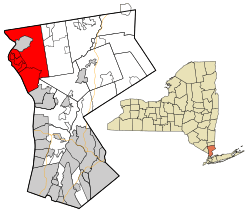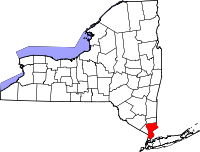Cortlandt, New York
| Cortlandt, New York | |
|---|---|
| Town | |
 Location of Cortlandt, New York | |
| Coordinates: 41°15′41″N 73°54′9″W / 41.26139°N 73.90250°WCoordinates: 41°15′41″N 73°54′9″W / 41.26139°N 73.90250°W | |
| Country | United States |
| State | New York |
| County | Westchester |
| Founded | 1788[1] |
| Government | |
| • Type | Manager-Council |
| • Town Supervisor | Linda Puglisi (D) |
| • Town Board |
Members
|
| Area[2] | |
| • Total | 50.02 sq mi (129.54 km2) |
| • Land | 39.26 sq mi (101.68 km2) |
| • Water | 10.76 sq mi (27.86 km2) |
| Elevation | 318 ft (97 m) |
| Population (2010) | |
| • Total | 41,592 |
| • Estimate (2016)[3] | 42,821 |
| • Density | 1,090.76/sq mi (421.15/km2) |
| Time zone | UTC-5 (Eastern (EST)) |
| • Summer (DST) | UTC-4 (EDT) |
| FIPS code | 36-18410 |
| GNIS feature ID | 0978871 |
| Website |
townofcortlandt |
Cortlandt is a town in Westchester County, New York, United States. The population was 41,592 at the 2010 census.[4]
Cortlandt is located at the northwest edge of the county, at the eastern terminus of the Bear Mountain Bridge. The town includes the villages of Buchanan and Croton-on-Hudson.
Commuter service to New York City is available via the Cortlandt train station and the Croton-Harmon train station, served by Metro-North Railroad.
U.S. Route 9 passes through the town along the Hudson River side.
History
The Bear Mountain Bridge Road and Toll House and Site of Old Croton Dam are listed on the National Register of Historic Places.[5]
Cortlandt is also known for its Revolutionary War history, specifically the location of the strategic Kings Ferry between Stony Point and Verplanck's Point, which George Washington's army used to cross the Hudson on its march to Yorktown, Virginia, in 1781. John Trumbull's full-length oil portrait of Washington at Verplanck's Point exists in two versions.
Geography
The town's western borders are the Hudson River and the city of Peekskill. Its northern borders are the towns of Philipstown and Putnam Valley in Putnam County. Its eastern border is the town of Yorktown. Its southern borders are the towns of New Castle and Ossining.
According to the United States Census Bureau, the town has a total area of 50.0 square miles (129.5 km2), of which 39.3 square miles (101.7 km2) is land and 10.8 square miles (27.9 km2), or 21.51%, is water.[4]
Demographics
| Historical population | |||
|---|---|---|---|
| Census | Pop. | %± | |
| 1790 | 1,932 | — | |
| 1820 | 3,421 | — | |
| 1830 | 3,840 | 12.2% | |
| 1840 | 5,592 | 45.6% | |
| 1850 | 7,758 | 38.7% | |
| 1860 | 10,074 | 29.9% | |
| 1870 | 11,694 | 16.1% | |
| 1880 | 12,664 | 8.3% | |
| 1890 | 15,139 | 19.5% | |
| 1900 | 18,703 | 23.5% | |
| 1910 | 22,255 | 19.0% | |
| 1920 | 21,023 | −5.5% | |
| 1930 | 26,492 | 26.0% | |
| 1940 | 11,016 | −58.4% | |
| 1950 | 14,146 | 28.4% | |
| 1960 | 26,336 | 86.2% | |
| 1970 | 34,393 | 30.6% | |
| 1980 | 35,705 | 3.8% | |
| 1990 | 37,357 | 4.6% | |
| 2000 | 38,467 | 3.0% | |
| 2010 | 41,592 | 8.1% | |
| Est. 2016 | 42,821 | [3] | 3.0% |
| U.S. Decennial Census[6] | |||
As of the census[7] of 2000, there were 38,467 people, 13,517 households, and 10,137 families residing in the town. The population density was 969.7 people per square mile (374.4/km²). There were 14,065 housing units at an average density of 354.5 per square mile (136.9/km²). The racial makeup of the town was 88.60% White, 4.59% African American, 0.21% Native American, 2.57% Asian, 0.01% Pacific Islander, 2.35% from other races, and 1.68% from two or more races. Hispanic or Latino of any race were 7.19% of the population.
There were 13,517 households out of which 39.3% had children under the age of 18 living with them, 64.3% were married couples living together, 7.9% had a female householder with no husband present, and 25.0% were non-families. 21.3% of all households were made up of individuals and 8.8% had someone living alone who was 65 years of age or older. The average household size was 2.75 and the average family size was 3.22.
In the town, the population was spread out with 26.5% under the age of 18, 5.3% from 18 to 24, 30.1% from 25 to 44, 25.3% from 45 to 64, and 12.8% who were 65 years of age or older. The median age was 39 years. For every 100 females, there were 95.8 males. For every 100 females age 18 and over, there were 92.7 males.
The median income for a household in the town was $75,442, and the median income for a family was $89,053. Males had a median income of $59,949 versus $41,115 for females. The per capita income for the town was $33,432. About 2.9% of families and 4.5% of the population were below the poverty line, including 4.1% of those under age 18 and 5.1% of those age 65 or over.
Government
Cortlandt is governed by a town board. Law enforcement services in Cortlandt are provided by the New York State Police and the Westchester County Department of Public Safety.
Communities and locations in Cortlandt
- Buchanan – the Village of Buchanan
- Chimney Corners – a hamlet north of Croton-on-Hudson
- Cortlandt Manor – a hamlet in the Town of Cortlandt
- Crompond – A hamlet partially in the Town of Cortlandt
- Croton-on-Hudson – the Village of Croton-on-Hudson
- Crugers – a hamlet of Cortlandt. Includes the Cortlandt train station.
- Furnace Woods
- Mohegan Lake – a hamlet partially in the Town of Cortlandt
- Montrose – a hamlet of Cortlandt
- Mount Airy – a neighborhood
- Oscawana – includes Oscawana Island
- Pleasantside
- Roe Park
- Teatown – a hamlet partially in the Town of Cortlandt
- Toddville
- Valeria
- Van Cortlandtville – The John Jones Homestead, Old St. Peter's Church, and Van Cortlandtville School are listed on the National Register of Historic Places.[5]
- Verplanck – a hamlet of Cortlandt
- Woodybrook
References
- ↑ "Archived copy". Archived from the original on 2016-05-11. Retrieved 2016-05-31.
- ↑ "2016 U.S. Gazetteer Files". United States Census Bureau. Retrieved Jul 5, 2017.
- 1 2 "Population and Housing Unit Estimates". Retrieved June 9, 2017.
- 1 2 "Geographic Identifiers: 2010 Demographic Profile Data (G001): Cortlandt town, Westchester County, New York". U.S. Census Bureau, American Factfinder. Retrieved January 29, 2013.
- 1 2 National Park Service (2009-03-13). "National Register Information System". National Register of Historic Places. National Park Service.
- ↑ "Census of Population and Housing". Census.gov. Archived from the original on May 12, 2015. Retrieved June 4, 2015.
- ↑ "American FactFinder". United States Census Bureau. Archived from the original on 2013-09-11. Retrieved 2008-01-31.
